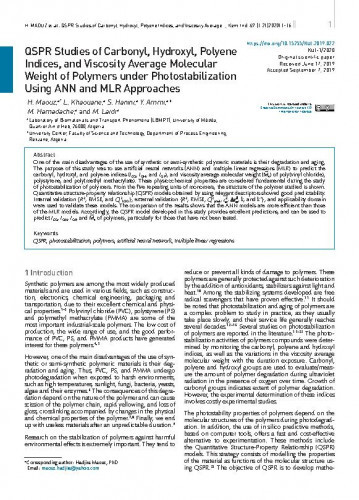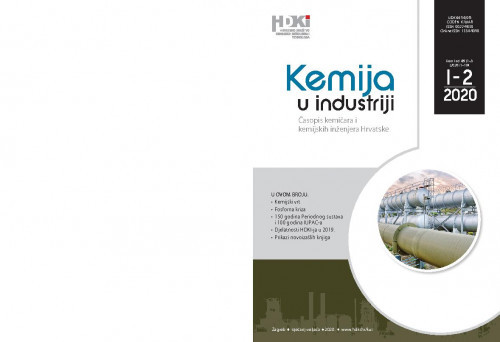One of the main disadvantages of the use of synthetic or semi-synthetic polymeric materials is their degradation and aging. The purpose of this study was to use artificial neural networks (ANN) and multiple linear regressions (MLR) to predict the carbonyl, hydroxyl, and polyene indices (ICO, IOH, and IOP), and viscosity average molecular weight (MV) of poly(vinyl chloride), polystyrene, and poly(methyl methacrylate). These physicochemical properties are considered fundamental during the study of photostabilization of polymers. From the five repeating units of monomers, the structure of the polymer studied is shown. Quantitative structure-property relationship (QSPR) models obtained by using relevant descriptors showed good predictability. Internal validation {R2, RMSE, and Q2LOO}, external validation {R2, RMSE, Q2pred, rm2, Δrm2, k, and k’}, and applicability domain were used to validate these models. The comparison of the results shows that the ANN models are more efficient than those of the MLR models. Accordingly, the QSPR model developed in this study provides excellent predictions, and can be used to predict ICO, IOH, IOP, and MV of polymers, particularly for those that have not been tested.; Jedan od glavnih nedostataka upotrebe sintetičkih ili polusintetičkih polimernih materijala je njihova razgradnja i starenje. Svrha ove studije je primjena umjetnih neuronskih mreža (ANN) i višestrukih linearnih regresija (MLR) za predviđanje karbonilnih, hidroksilnih i polienskih indeksa (ICO, IOH i IOP) i prosječne molekulske mase viskoznosti (MV) poli(vinil-klorida), polistirena i poli(metil metakrilata). Ta fizikalno-kemijska svojstva smatraju se važnim tijekom proučavanja fotostabilizacije polimera. Iz pet ponavljajućih jedinica monomera prikazana je struktura ispitivanog polimera. Kvantitativni modeli odnosa strukture-svojstava (QSPR) dobiveni primjenom relevantnih deskriptora pokazali su dobru predvidljivost. Za potvrdu tih modela provedene su: interna provjera {R2, RMSE i Q2LOO}, vanjska provjera {R2, RMSE, Q2pred, rm2, Δrm2, k i k’} i domena primjenjivosti. Usporedba rezultata pokazuje da su modeli ANN učinkovitiji od modela MLR. Prema tome, model QSPR razvijen u ovoj studiji pruža izvrsna predviđanja i može se primjenjivati za predviđanje ICO, IOH, IOP i MV polimera, posebno za one koji nisu testirani.
Sažetak

 Kemija u industriji : 69,1/2 (2020) / glavni i odgovorni urednik Nenad Bolf.
Kemija u industriji : 69,1/2 (2020) / glavni i odgovorni urednik Nenad Bolf.